Aztec mythology, a rich tapestry of vibrant tales and deities, forms an integral part of the cultural and spiritual fabric of the ancient Aztec civilization, which flourished in central Mexico from the 14th to 16th centuries. Among its pantheon stands Metztli, a deity of considerable intrigue and reverence, often identified as the god of the moon. This enigmatic figure embodies not just the physical moon, but also encapsulates the mystical and spiritual aspects associated with lunar deities in various cultures. In Aztec culture, Metztli held a special place, influencing rituals, calendars, and daily life, reflecting the civilization’s deep connection with celestial bodies. Understanding Metztli’s role unravels not only the complex mythology of the Aztecs but also offers a window into their understanding of the cosmos and its influence on terrestrial life.
| Attribute | Metztli Information |
|---|---|
| Origin | Aztec Mythology |
| Deity Type | God of the Moon |
| Role | God associated with the moon, night, and the passage of time |
| Moon Phases | Often depicted with different phases of the moon, symbolizing lunar cycles |
| Cultural Impact | A significant figure in Aztec beliefs about time, calendars, and the moon |
| Depictions | Featured in Aztec art and rituals, particularly those related to the moon and timekeeping |
1. Historical Context and Mythological Significance
Overview of the Aztec Civilization
The Aztec civilization, a Mesoamerican cultural powerhouse, thrived from the 14th to the 16th century in central Mexico, notably in the region now known as Mexico City. This period marked the zenith of their power until the Spanish conquest led to their decline. Renowned for their complex societal structures, the Aztecs were also celebrated for their architectural feats, including the famed Templo Mayor and the pyramids of Teotihuacan. Their artistic expressions were diverse, encompassing pottery, sculpture, and exquisite goldsmithing. Intellectually, they made significant strides in astronomy and mathematics and developed an intricate calendar system.
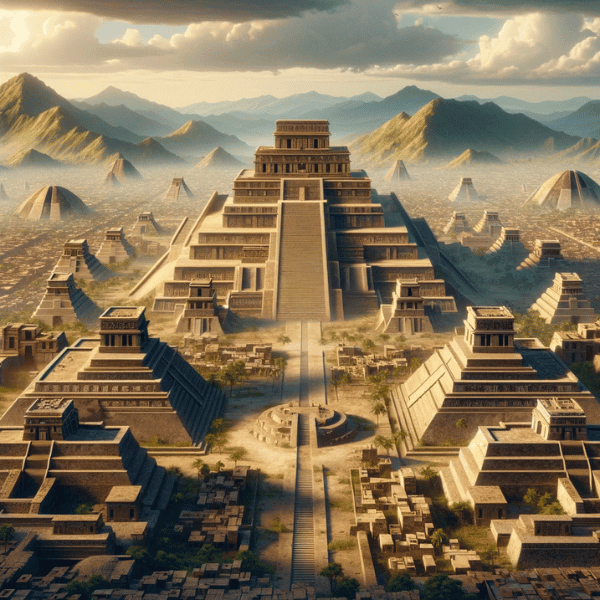
Metztli in Aztec Mythology
Metztli, deriving its name from the Nahuatl language, stands prominently in Aztec mythology as the moon deity. The interpretation of Metztli’s gender varies, with depictions oscillating between male and female forms, reflecting the multifaceted nature of this celestial entity. Metztli’s iconography is rich and varied, often intertwined with other deities and natural phenomena, such as tides and timekeeping. This deity’s role in the Aztec pantheon was pivotal, influencing numerous rituals and ceremonies, and holding a significant place in the Aztec understanding of the cosmos and natural cycles. Metztli’s mythology thus played a critical role in shaping the spiritual landscape of the Aztec civilization.
2. The Mythology of Metztli
Metztli’s Most Famous Myths and Legends
Metztli, the enigmatic moon deity of the Aztec pantheon, features in several captivating myths that are rich in symbolism and cultural significance. One of the most renowned legends describes Metztli’s creation, where the god sacrifices itself to become the moon, mirroring the sun’s earlier sacrifice. This tale often depicts a struggle between Metztli and the sun, reflecting the celestial dance between night and day. Another notable legend involves Metztli’s role in the Aztec creation myth, where the deity plays a pivotal part in the creation and destruction of different worlds or “Suns” in Aztec cosmology.
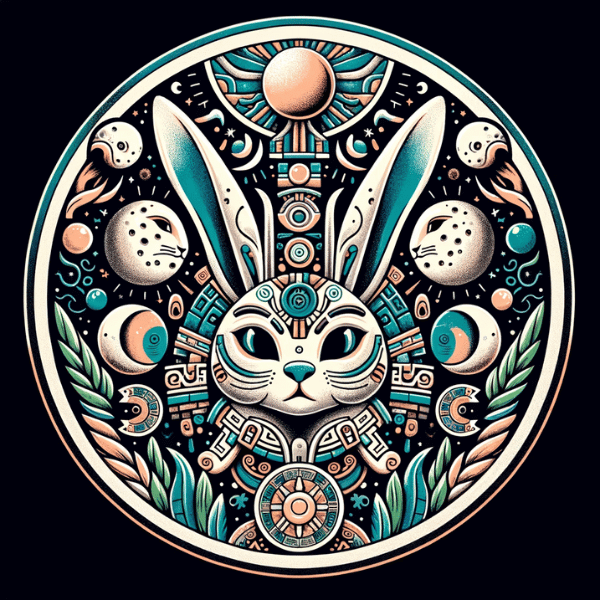
Analysis of Metztli’s Role and Symbolism
Metztli’s myths serve as more than just stories; they are deeply symbolic and reflect the Aztecs’ intricate understanding of the cosmos. In the tale of Metztli’s sacrifice, the moon’s creation is not just a physical event but a spiritual journey, symbolizing renewal, rebirth, and the balance of cosmic forces. This legend highlights the theme of self-sacrifice and regeneration, essential concepts in Aztec religious beliefs. Similarly, in the creation myth, Metztli’s involvement in the cycles of creation and destruction underscores the belief in the cyclical nature of time and existence.
Metztli’s portrayal in these myths often carries dualistic elements, such as light and darkness, life and death, suggesting the deity’s role in maintaining cosmic equilibrium. The interplay between Metztli and the sun in these stories symbolizes the balance of power and the interconnectedness of celestial bodies, reflecting the Aztecs’ deep reverence for the natural world and its rhythms.
3. Iconography and Worship Practices
Metztli’s Iconography in Aztec Art and Architecture
Metztli, revered as the moon deity, is depicted with distinctive iconography in Aztec art and architecture. Commonly, Metztli is portrayed with a stark contrast of light and dark, symbolizing the phases of the moon. In sculptures and reliefs, Metztli often appears adorned with symbols of night and celestial phenomena, such as stars and clouds. Some depictions show the deity with a rabbit, a reference to the Aztec belief that a rabbit’s image could be seen on the moon’s surface. Architecturally, Metztli’s influence is evident in temple designs and alignments, which often incorporate lunar cycles and events. The Templo Mayor in Tenochtitlan, for instance, reflects a deep understanding of celestial mechanics, with certain structures aligned to mark important lunar dates.
Examination of Historical Worship Practices and Rituals
The worship of Metztli was an integral part of Aztec religious life, marked by elaborate rituals and ceremonies. One significant observance was the monthly festival, which aligned with the lunar cycle. These celebrations often involved offerings to appease and honor Metztli, including sacrifices and the burning of incense. The nature of these offerings varied, sometimes including animals or symbolic objects, believed to ensure the moon’s continued protection and benevolence. Priests played a central role in these rituals, performing intricate dances and chants under the moonlight, believed to strengthen the connection between the deity and its worshippers.
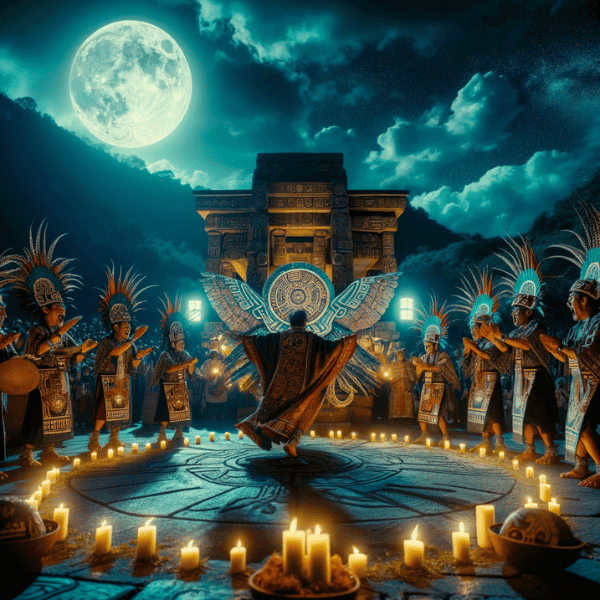
Furthermore, Metztli was also integral to agricultural practices, with farmers closely observing the lunar phases for planting and harvesting. This practice reflects the belief in the moon’s influence over crop growth and fertility.
The worship of Metztli extended beyond formal rituals, permeating daily life and personal spirituality. The moon deity was often invoked in personal prayers for guidance, particularly in matters related to change and transition, echoing the moon’s ever-changing phases.
4. Metztli’s Influence on Aztec Society
Metztli’s Impact on Aztec Calendars
Metztli, the moon deity, played a pivotal role in shaping the Aztec calendars, an essential aspect of their societal and cultural framework. The Aztecs utilized two primary calendar systems: the Xiuhpohualli, or the solar year calendar, and the Tonalpohualli, a 260-day ritual calendar. Metztli’s influence is particularly prominent in the latter, where lunar cycles were integral in determining important religious and ceremonial dates. The Aztecs believed that specific phases of the moon were auspicious for certain activities, and this belief guided the planning of festivals, ceremonies, and religious observances. This intricate calendar system, deeply intertwined with lunar phases, showcases Metztli’s significant impact on the temporal organization of Aztec society.
Metztli in Agriculture
Agriculture, a cornerstone of Aztec life, was heavily influenced by Metztli. The Aztecs observed the moon’s phases for cues on agricultural activities like planting and harvesting. They believed that the lunar cycles had a direct impact on crop growth and fertility. For instance, certain phases of the moon were considered more favorable for planting seeds, while others were believed to be better for harvesting. This reliance on lunar cycles highlights Metztli’s importance in sustaining and guiding agricultural practices, a vital aspect of Aztec survival and prosperity.
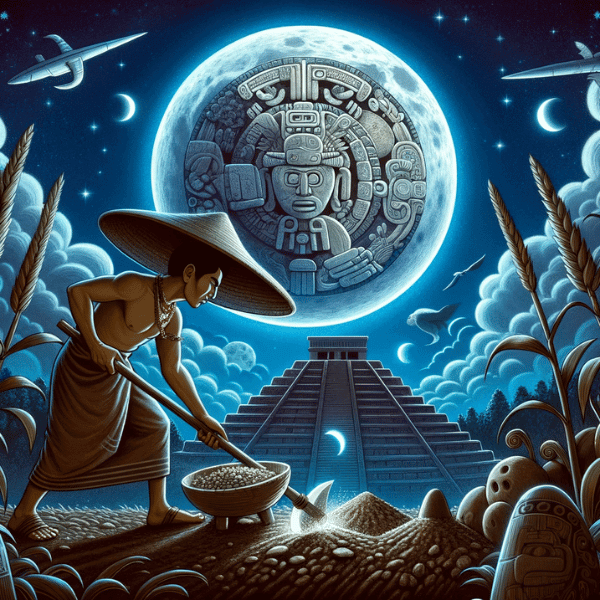
Daily Life and Lunar Cycles
Beyond calendars and agriculture, Metztli’s influence permeated the daily life of the Aztecs. People often used the phases of the moon to mark time and plan daily activities. They observed the changing of the moon with keen interest and associated its various phases with various cultural beliefs and superstitions. For example, they believed that certain moon phases were auspicious for starting new ventures or conducting important community events.
Lunar Cycles and Cultural Significance
The lunar cycles held deep cultural and spiritual significance for the Aztecs. They saw the waxing and waning of the moon as symbolic of the cycle of life, death, and rebirth. Metztli was often associated with themes of transformation and renewal, echoing the moon’s constant changes. This connection between the lunar cycles and the larger cosmic order played a crucial role in the Aztec understanding of the universe and their place within it. Ceremonies and rituals conducted under the moonlight were not just religious practices but also a means of aligning with the cosmic rhythm.
5. Contemporary Relevance
Modern Interpretation and Relevance of Metztli
In contemporary times, Metztli, the Aztec moon deity, continues to hold a place of intrigue and inspiration, transcending its historical and mythological origins. Modern interpretations often view Metztli through the lens of cultural heritage and identity, especially among communities with Aztec or broader Mesoamerican ancestry. This deity symbolizes a connection to ancestral wisdom and the natural world, resonating with contemporary themes of environmental awareness and the search for spiritual meaning. In psychology and philosophy, scholars frequently explore Metztli’s symbolism of change and renewal, offering insights into human nature and the cyclical patterns of life.
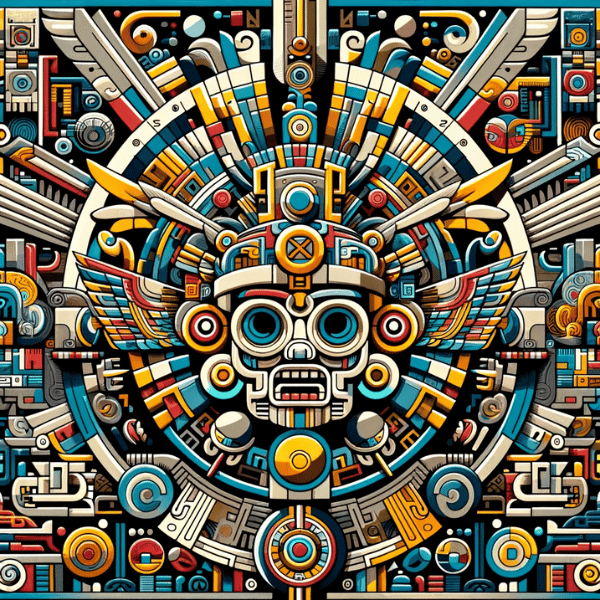
Influence on Contemporary Culture, Art, and Festivals
Metztli’s legacy is evident in various aspects of contemporary culture, particularly in art and festivals. Artists, both in Mexico and globally, often draw upon the rich imagery associated with Metztli, using it to explore themes of mysticism, nature, and cultural identity. These artistic expressions can be seen in mediums ranging from painting and sculpture to modern digital art forms.
Festivals and cultural events also reflect Metztli’s enduring influence. In Mexico and in Mexican communities around the world, traditional celebrations often incorporate aspects of Aztec mythology, including homage to lunar deities. These events serve as a means of preserving and celebrating indigenous heritage, blending ancient traditions with modern practices. During such festivals, traditional dances, music, and rituals are performed, some of which have origins or connections to lunar worship and the reverence of Metztli.
Educational and Academic Interest
There is also a growing academic interest in Metztli and Aztec mythology at large. Universities and cultural institutions around the world conduct research and host exhibitions that explore the rich heritage of the Aztec civilization. These academic pursuits not only provide historical insights but also foster a deeper appreciation of the cultural and spiritual depth of Mesoamerican societies.
6. Conclusion
In conclusion, Metztli, the Aztec moon deity, embodies a rich tapestry of cultural, spiritual, and cosmic significance. From shaping the Aztec calendars and agricultural practices to symbolizing themes of renewal and transformation, Metztli’s influence permeated various facets of Aztec life. The deity’s diverse iconography and the deep-rooted lunar worship practices underscore its importance in the Aztec pantheon. Today, Metztli’s legacy continues to inspire contemporary art, culture, and spirituality, reflecting the enduring allure and relevance of Aztec mythology. This ancient deity, representative of change and the cyclical nature of life, serves as a bridge connecting past traditions with modern interpretations, illustrating the timeless nature of mythological narratives and their power to resonate across generations.
